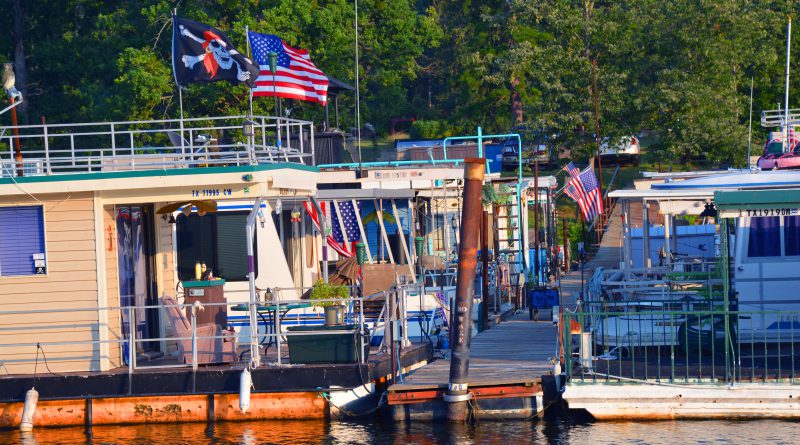Longview Yacht Club

Lake O The Pines – The son has become the father, returning to the lake with a boy whose time has come to learn the things that he learned here.
Among the best of Dustin Briscoe’s memories are days spent mastering winds drawing him into an alternate universe of moving silence, a quiet punctuated by the slap of waves breaking against a hull carving the wake of his father’s boat.
Faith in his father’s teaching made learning easy in those days. Sailing is an ancient thing passed down from adventurers and explorers spreading commerce, conquerors moving armies of invasion.
Learned young, the use of a rudder balancing the energy captured in sails against the leverage of the keel becomes a natural thing, like breathing.
“It’s like stepping back, being closer to nature,” Dustin said. He learned aboard a 16-foot Viper, an open hull with a single sail.
It took a year of work to restore his father’s last boat, a more complex cruiser with a sleeping berth below deck, two jibs and a mainsail requiring more skill and coordination and likewise providing more mastery of sails capturing the wind.
A “cutter” rig, the design of his 23-foot Venture Newport is a scant two centuries old.
“It’s similar to the more nimble boats once used to guide ocean-going square riggers into port,” said Dustin.
A whip-cord length of something under 60 pounds, in addition to the edge gained with his growing sailing experience, son Dylan will have an added weight advantage in the Longview Yacht Club’s upcoming “You Make It, You Sail It,” event.
Like a Cub Scout Pinewood Derby, everybody starts with building their racer from a kit – 2 x 4 frame for the lawn chair webbing cockpit. Other components include needed lines, foam board, PVC-pipe and fittings engineered into controls, Plexiglas, duct tape, shower board, a minimum of odds and ends hardware, a parachute cut and hemmed into a spinnaker and a light-weight extendable aluminum mast that can also be used as an extension for your standard-issue paint roller.
“After the race you could go home and paint the living room,” said Pete Pattullo, who searched the world via internet for parts fitting his $150 sailing kit, a plan turning out a simple vessel surprisingly akin to an America’s Cup racer, but with minimalist concepts of control owing to sail design.
Unlike the rigid control points of a sail controlled with a boom, a spinnaker is more like a kite with design improvements curving its edges to form a cup. When deployed to catch wind, in sailor lingo a spinnaker is “flying.”
Controlled by two lines, if you can’t figure out how to fly a spinnaker, you shouldn’t be driving.
There’s a catch — figuring it out and flying a spinnaker with precision control are two different things.
“The same way the current of a stream bends with the channel, the wind stream is continually shifting. Flying a spinnaker requires continual adjustment, which is what makes the race competitive,” said LYC’s Al Hildebrand, one of the club’s several past commodores who will join with volunteers to help racers construct their $150 “You Make It, You Sail It” kit boats before race day. (Watch for dates posted at longviewyachtclub.org in advance of the May 30 event.)
Beyond providing construction help, club members have ideas for modifications that will both preserve the kit boat and enhance its speed, said Pete Pattullo. Unique among the LYC cast, Pete’s a three-time overall winner of the Lakewood Yacht Club’s Harvest Moon Regatta.
One national sailing champion is among his crew of five, a competitive team that over its years has set sail from 85 ports on the Great Lakes, where they sail for a month each summer.
“Every member of our team is a skipper,” Pete said, “which puts a lot of pressure on the guy in the helm because no matter what you do, everybody else thinks they could have done it a bit better.”
Most recently, they finished second among 150 racing across Lake Michigan from Chicago to Milwaukee.
Factoid: The third highest concentration of sailboats in the continental US is found in Texas at Clear Lake, home of the club organizing the Harvest Moon race.
Same as the LYC’s upcoming “You Make It, You Sail It” event, all proceeds go to charity.
There’s no purse associated in any event in which Pete sails.
“The thing I appreciate about the people drawn into competition, it’s got nothing to do with money. It’s about the love of sailing,” he said.
When he was a kid, his family had a cottage and a Hoby Cat on Lake Huron. As a veteran coming out of the Navy, “I traded my trailer house for my first boat,” Pete said.
His motive for designing an inexpensive boat in a kit comes from the same mentality.
As opposed to a closed shop of the elite, for the whole of its 28-year history, the LYC has operated in expansion mode.
“It’s a social thing,” Mr. Hildebrand said. “Every time we teach somebody to sail, we’ve got a potential member. For anybody who’s ever had as much as a passing thought that they might enjoy sailing, most often a day on the water cements the idea.”
While most of the club’s 30 slips are filled, there’s room to build. Dues are $45 a month. There are nearly as many members who don’t own boats as those who do. For members checked out to sail, there’s a 25-foot Catalina available for $20 a day.
“That’s an unheard of deal,” said Dustin Briscoe, the father who signed on with the tribe to have a base for teaching his son. “It’s a nice boat with a berth below deck and it’s relatively easy to sail.”




